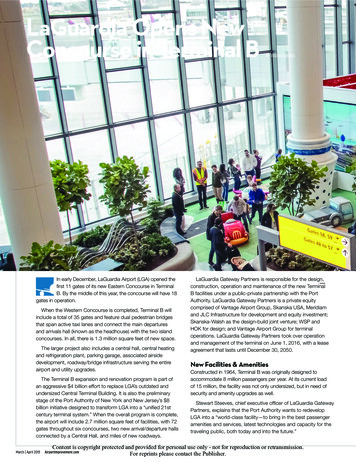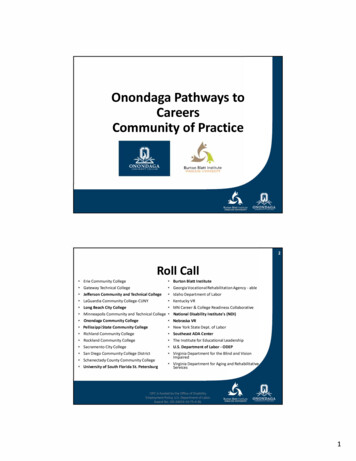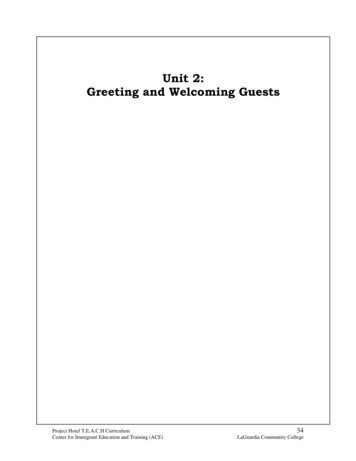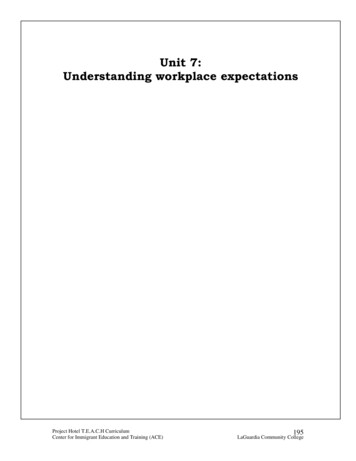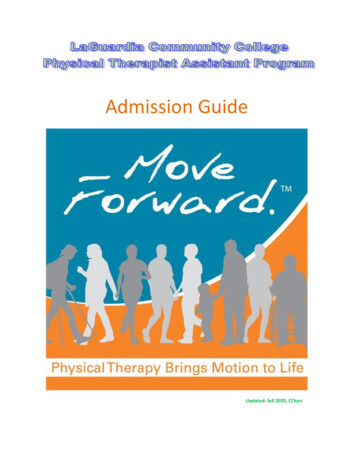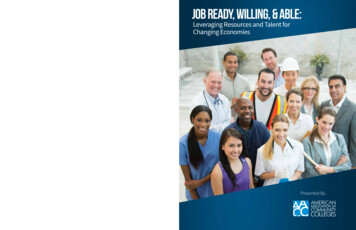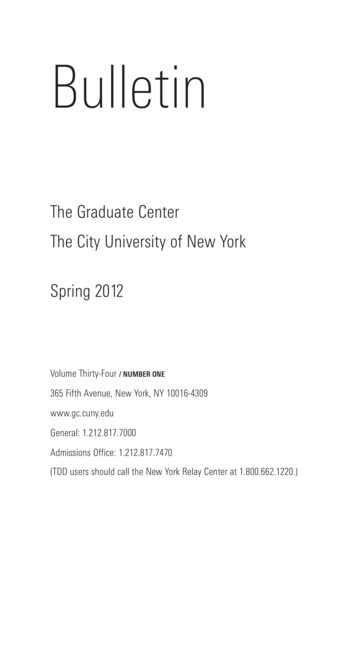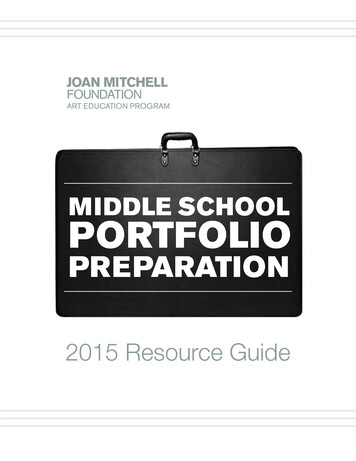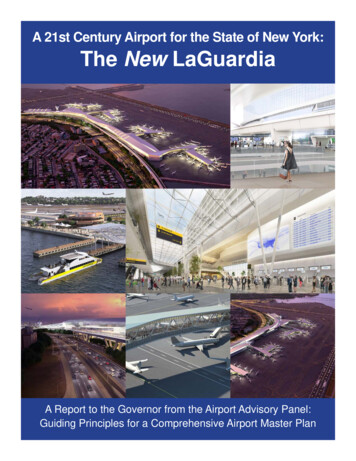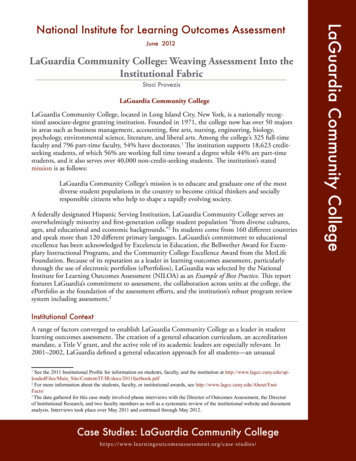
Transcription
June 2012LaGuardia Community College: Weaving Assessment Into theInstitutional FabricStaci ProvezisLaGuardia Community CollegeLaGuardia Community College, located in Long Island City, New York, is a nationally recognized associate-degree granting institution. Founded in 1971, the college now has over 50 majorsin areas such as business management, accounting, fine arts, nursing, engineering, biology,psychology, environmental science, literature, and liberal arts. Among the college’s 325 full-timefaculty and 796 part-time faculty, 54% have doctorates.1 The institution supports 18,623 creditseeking students, of which 56% are working full time toward a degree while 44% are part-timestudents, and it also serves over 40,000 non-credit-seeking students. The institution’s statedmission is as follows:LaGuardia Community College’s mission is to educate and graduate one of the mostdiverse student populations in the country to become critical thinkers and sociallyresponsible citizens who help to shape a rapidly evolving society.A federally designated Hispanic Serving Institution, LaGuardia Community College serves anoverwhelmingly minority and first-generation college student population “from diverse cultures,ages, and educational and economic backgrounds.”2 Its students come from 160 different countriesand speak more than 120 different primary languages. LaGuardia’s commitment to educationalexcellence has been acknowledged by Excelencia in Education, the Bellwether Award for Exemplary Instructional Programs, and the Community College Excellence Award from the MetLifeFoundation. Because of its reputation as a leader in learning outcomes assessment, particularlythrough the use of electronic portfolios (ePortfolios), LaGuardia was selected by the NationalInstitute for Learning Outcomes Assessment (NILOA) as an Example of Best Practice. This reportfeatures LaGuardia’s commitment to assessment, the collaboration across units at the college, theePortfolio as the foundation of the assessment efforts, and the institution’s robust program reviewsystem including assessment.3Institutional ContextA range of factors converged to establish LaGuardia Community College as a leader in studentlearning outcomes assessment. The creation of a general education curriculum, an accreditationmandate, a Title V grant, and the active role of its academic leaders are especially relevant. In2001–2002, LaGuardia defined a general education approach for all students—an unusualSee the 2011 Institutional Profile for information on students, faculty, and the institution at http://www.lagcc.cuny.edu/uploadedFiles/Main Site/Content/IT/IR/docs/2011factbook.pdf2For more information about the students, faculty, or institutional awards, see http://www.lagcc.cuny.edu/About/FastFacts/3The data gathered for this case study involved phone interviews with the Director of Outcomes Assessment, the Directorof Institutional Research, and two faculty members as well as a systematic review of the institutional website and documentanalysis. Interviews took place over May 2011 and continued through May 2012.1Case Studies: LaGuardia Community case-studies/LaGuardia Community CollegeNational Institute for Learning Outcomes Assessment
move for community colleges, where liberal arts may not integrate well into professional or vocational curricula. Moving beyond a traditional distribution approach, LaGuardia focused general education on competencies or proficiencies required across all degree programs. (These core competencies include critical literacy,quantitative reasoning, oral communication, research and information literacy, and technical literacy.)Students are required to meet requirements for both general education as well as for their degree programs.At the same time, LaGuardia was also responding to pressure from the Middle States Commission on HigherEducation (Middle States) to establish a new assessment plan and to document how it used assessmentevidence to improve student learning. To support this work, the institution successfully applied for a TitleV grant allowing it to plan, pilot, and scale the now nationally recognized ePortfolio system.4,5 Along withLaGuardia’s participation in Integrative Learning: Opportunities to Connect, a project of the Association ofAmerican Colleges and Universities (AAC&U), these factors led LaGuardia to very closely examine studentlearning outcomes and how to assess them.6From the beginning, the college’s assessment plan focused on improving student learning on commonoutcomes that all students at LaGuardia could attain. According to Dean Paul Arcario and Professor JamesWilson, assessment at La Guardia was to be transformative: whether or not we’re comfortable with it, assessment is about revolution. If we really listen tostudents and take them seriously, then our teaching and learning methodologies will change Finely tuned assessment efforts help keep us from being self-satisfied or complacent about theworkplace we love Through assessment we challenge ourselves to rethink our ways of teaching,structuring the curriculum, working together, and even knowing itself. It provides a means forself-correcting action and for the continual expansion of our thinking about the idea and purposeof higher education.7Dean Arcario advances assessment by participating on the campus Assessment Leadership Team, by financially supporting faculty and staff to participate in conferences, by offering a range of assessment-focusedcampus workshops, and by making assessment a priority for all programs. LaGuardia President Gail O.Mellow, also an advocate of assessment, often asks, “How do you know that students are learning?” She readsall of the Periodic Program Reviews (PPRs) and gives feedback based on her readings. Known as someonewho believes in the importance of using evidence to make decisions, she focuses her support on projects thatcan show how they evaluate their impact on student success. These are among the ways that LaGuardia’sacademic leadership has shown commitment to assessment activity on campus.A sustained effort by academic leadership and key faculty leaders has overcome some initial faculty concernsthat assessment might be used to target individual faculty members. Over time, assessment has become amotif on campus as growing numbers of faculty assess student learning and focus programmatic decisionsand discussions on ways to improve it. The engagement of these faculty and the discussions across campushave shown that assessment efforts are not focused on individual faculty performance—an initial miscon4LaGuardia launched the ePortfolio with grant funds and sustains it with campus funding. It continues to attract Title V grants and FIPSEGrants to advance its work on campus, across the CUNY system, as well as internationally. See nes.htm to learn about the reach of the ePortfolio system with the Making Connections National Resource Center (http://www.lagcc.cuny.edu/connections/). In addition, LaGuardia’s ePortfolio is often mentioned in the Association for Authentic, Experiential,and Evidence-Based Learning (AAEEBL) (http://www.aaeebl.org/) conferences and resource lists.LaGuardia’s ePortfolio has been the focus of several publications, such as Eynon, B. (2009). Making connections: The LaGuardiaeportfolio. In D. Cambridge, B. Cambridge, & K. B. Yancey (Eds.), Electronic portfolios 2.0: Emergent research on implementation andimpact (pp. 59–68). Sterling, VA: Stylus; Arcario, P., Eynon, B., & Lucca, L. (2010). The power of peers: New ways for students to support students. In J. Summerfield & C. Smith (Eds.), Making teaching and learning matter: Transformative spaces in higher education(pp. 195–218). New York: Springer; and Enyon, B. (2009) “It helped me see a new me: ePortfolio, Learning and Change at LaGuardiaCommunity College in Filtered the on-line journal of Academic Commons”, folio-learning-and-change5See http://www.aacu.org/integrative learning/index.cfmArcario, P., & Wilson, J. (2007). Putting it together: General education at LaGuardia Community College. In J. Summerfield, & C.Benedicks (Eds.), Reclaiming the public university: Conversations on general and liberal education. New York, NY: Peter Lang.67National Institute for Learning Outcomes Assessment 2
ception—but instead on a broader evaluation of program and general institutional goals. The combinationof top-down and grass-roots approaches has been effective. The 2012 Final Evaluation Team report fromthe visiting Middle States team praised LaGuardia for creating a broad culture of assessment on campus.8Support from the president and dean has moved the institution forward and assessment now permeates alllevels of the institution.LaGuardia’s ePortfolio InitiativeA central feature of the college’s outcomes assessment process, LaGuardia’s ePortfolio initiative helps groundthe college’s entire assessment cycle in the authentic work of students and faculty by providing a means forcollecting large quantities of student artifacts and organizing them for faculty review in the Periodic ProgramReview and Benchmark Reading processes, discussed below. The ePortfolio initiative engages large numbersof faculty and students in efforts to advance learning and teaching campus wide. Launched in 2002, thisinitiative has grown dramatically over the years with more than 50,000 students creating portfolios in thepast five years. Working recursively, students use ePortfolio to collect their academic work, to associate itwith competencies, and to reflect on their learning from their first-year seminars to their capstone courses.Creating an evolving, digital representation of what they have learned, students can share their ePortfolioswith anyone they choose—peers, faculty, family and friends, potential employers, and transfer institutions.As one student from Bangladesh explained to an interviewer:If somebody asked me “What did you do in the laboratory? What did you learn in your education? What did you do?” When I go back to my country, somebody can ask me “What did youdo in the US?” This is the only thing I can show them, “This is what I have done. These are mygrades, these are my projects, assignments.” They can see everything. It’s me. This is the bestthing that I saw through the ePortfolio .9LaGuardia leaders argue that successful use of ePortfolio for outcomes assessment requires faculty andstudent buy-in. Ensuring that the ePortfolio directly benefits students is critical in this regard. Professionaldevelopment seminars help LaGuardia faculty use the ePortfolio as a pedagogical tool to support integrative learning. Reflecting on their learning across disciplines and semesters, students are encouraged to makeconnections and consider their own growth and change. Creating digital self-portraits, students craft newidentities as learners and take greater responsibility for their work. Data gathered in the Community CollegeSurvey of Student Engagement shows that, compared to college means, students using the ePortfolio notonly demonstrate higher levels of engagement in critical thinking, writing, and other key academic behaviors, they are also more likely to see strong connections between their coursework and their personal goalsand values. Over the past five years, outcomes data show a strong correlation between taking ePortfoliointensive courses and pass rates, next-semester retention, and progress toward graduation.10LaGuardia’s work with the ePortfolio has drawn international attention and recognition from the AAC&U,The Chronicle of Higher Education, and the Carnegie Foundation for the Advancement of Teaching.11Building on its success, LaGuardia has attracted two FIPSE grants for its Making Connections NationalResource Center, which leads a community of practice linking 50 campuses nationwide—from BostonNational Institute for Learning Outcomes Assessment 3
University and Virginia Tech to Salt Lake Community College—helping them advance their own ePortfoliopractice.12 Last year, the Lumina Foundation publication Focus, highlighted LaGuardia’s ePortfolio initiativeas an exemplary approach for measuring student learning.13Cross-Campus EffortsAssessment efforts at LaGuardia are primarily supported by the Office of Academic Affairs and the CenterforTeaching and Learning. Additionally, the Office of Institutional Research and Assessment (OIRA) playsa supplemental role in the activities of student learning outcomes assessment, managing the CommunityCollege Survey of Student Engagement and providing outcomes data to programs, as requested (https://www.laguardia.edu/IR/IR-facts/). For example, in support of a project with the mathematics departmentto trace the success of students as they moved through a series of courses, OIRA analyzed course pathwaysand scores on placement tests to find correlations with retention and student success. This informationwas then used by the department for improving the curriculum. OIRA seeks to provide this type ofsupport for units on campus in ways that can directly impact teaching and learning through the use ofquantitative analysis.Center for Teaching and LearningLaGuardia’s Center for Teaching and Learning (CTL), founded in 2001 and led by the Assistant Dean forTeaching and Learning, Bret Eynon, plays a critical role in supporting the assessment of learning outcomesacross the college and in building a campus culture focused on teaching and learning.14 The CTL coordinates the ePortfolio initiative by leading faculty seminars on ePortfolio technology and integrative learning;providing workshops on outcomes assessment; training peer mentors to support ePortfolio courses; andmanaging ePortfolio technology, data, and artifacts. The CTL connects these assessment-focused efforts toa broader array of programs focused on learning, teaching, and scholarship.15Each year the CTL offers an average of 12 to 15 distinct but parallel year-long faculty seminars. And eachyear, an average of over 200 full-time faculty apply for and take part in one or more of these seminarprograms. Beyond its ePortfolio programs, CTL seminars offered in recent years have ranged from“Designed for Learning” (exploring the role of digital technology in supporting inquiry learning) and“Project Quantum Leap” (contextualizing basic skills education in mathematics) to interdisciplinary“Learning Communities,” “New Faculty Colloquium,” and “Teaching the City,” a seminar focused on waysto use experiential learning and the resources of the city to strengthen student learning. The CTL regularlyoffers seminars focused on one or more of the General Education core competencies such as “Writing inthe Disciplines” or “Oral Communication Across the Curriculum.” All seminars are led by faculty-staffteams and provide stipends or released time to recognize faculty participation. According to the Dean, datagathered by OIRA suggests a correlation between the seminars and improved student outcomes, includingincreased course completion, improved course pass rates, and higher rates of next-semester retention. Inaddition to the ePortfolio and the core competency seminars, two other efforts led by the CTL buttress theoutcomes assessment process. Seeking to build a culture of evidence, the CTL offers a Carnegie Seminaron the Scholarship of Teaching and Learning and publishes In Transit: The LaGuardia Journal of Learningand Teaching, both of which encourage faculty to use the tools of scholarship to analyze student learning intheir classrooms. In addition, the CTL offers mini-grants of up to 7,500 designed to help programsprepare for and follow up on their Periodic Program Reviews (PPR). As described below, many programsuse these grants to “close the loop”—implementing the recommendations emerging from the PPRs—torevise curri-cula, develop department-based faculty development, and reach out to adjunct faculty. TheLaGuardia lead-ership see these efforts as “critical to ensuring that the outcomes assessment processeffectively guides active educational improvement.”16See http://www.lagcc.cuny.edu/connections/ to learn more about LaGuardia’s Making Connections center.See http://www.helios.org/uploads/docs/Focus-Winter 2011.pdf14The CTL was awarded a Hesburgh Certificate of Excellence for the Improvement of Undergraduate Education in 2004.15See http://www.lagcc.cuny.edu/ctl/default.aspx16See this site to learn more: https://www.laguardia.edu/assessment/1213National Institute for Learning Outcomes Assessment 4
Outcomes Assessment in the Office of Academic AffairsWhile the OIRA and the CTL contribute to outcomes assessment at LaGuardia, the process is coordinatedby the Office of Academic Affairs, through the Assessment Director and the Assessment Leadership Team,which consists of the Dean, Assistant Dean, several faculty members, the ePortfolio Director, and a student.The Assessment Director, Prof. Marisa Klages, is given 12 hours of release time for the position but stillmaintains a teaching role in addition to these administrative duties. The role of the director is to convenethe Assessment Leadership Team, conduct assessment workshops, and assist departments with their PeriodicProgram Review process, or PPRs.17Mandated by the City University of New York, of which LaGuardia is a member institution, the PPRprocess requires all programs at an institution to be reviewed within a 10-year time frame. LaGuardiaprograms are reviewed typically every five to seven years. LaGuardia also uses the PPR process to look atother organized but non-degree-granting systems at the college such as basic skills courses, the library, andthe ESL program. General education at LaGuardia has identified five core competencies for all students. ThePPRs assess the program’s achievement both in these core competencies as well as in programmatic competences established by program directors and program faculty. The program under review does a self-studyreport, responding to the following questions:1. What competencies/knowledge do we want students in the program to graduate with (includescore and programmatic competencies)?2. Are students in the program graduating with those competencies and knowledge sets? How do weknow?3. What changes do we need to make to improve student learning in these areas? What steps will wetake to strengthen our curriculum and pedagogy to more effectively help students achieve thesecompetencies?To answer these questions, programs engaged in a PPR work with the Office of Academic Affairs to identifythe issues and concerns to be examined, and they collect data with the help of the OIRA (such as graduationrates, retention rates, and enrollment trends). Both core and programmatic competencies are mapped to thecurriculum, aligning with current disciplinary or industry standards when applicable. Given the importanceof transfer and job placement to the community college, the program must also provide information in thePPR about the transferability of the courses and job placement.Evaluation of the artifacts of student learning collected through ePortfolio plays a defining role in the PPRprocess. All programs designate courses—from introductory surveys to capstone courses—in which studentssubmit a major assignment to the ePortfolio assessment area. With help from the CTL, a random sampleof artifacts is prepared. A faculty team from both within and outside the program uses a scoring rubric toreview these artifacts and assess the core and programmatic competencies. This faculty group offers recommendations to the program. Programs then create an action plan detailing how they will address the recommendations and improve student learning in the designated areas; this plan is built into the program’sstrategic work plan for the following year.18While the process for assessing student work is well established, LaGuardia continues to consider ways toimprove it. For instance, whereas the PPR process allows departments and programs to assess student progress within a program or major, providing a rich source of assessment data for the college, LaGuardia feltit also needed a more comprehensive overview of general education. To augment the findings of the PPR,LaGuardia conducted its first college-wide “Benchmark Assessment Reading” in 2011–2012. This processinvolved 34 faculty members in 14 programs who read samples, critiqued the rubrics, and revised them.17http://www.lagcc.cuny.edu/assessment/18For more information on PPRs at LaGuardia, see ent/docs/PPR%20Guidelines.pdfNational Institute for Learning Outcomes Assessment 5
Working in teams based on the core competencies, these faculty members read student artifacts depositedunder 25 credits and over 45 credits, blindly scoring samples from both levels to assess student progress onthe core competencies. These readings for the first time allowed LaGuardia a comprehensive look at studentgrowth and learning over time. The results showed that while LaGuardia students were not yet graduatingwith the full level of competencies sought by the college, students across the college were making significant gains in key general education competencies.19 More broadly, these results showed that it is possible tomeasure student growth on a large scale, using authentic artifacts instead of standardized tests. In the era ofsharp criticism such as that in Academically Adrift and widespread skepticism about higher education’s abilityto demonstrate its impact, LaGuardia’s leaders find these results particularly meaningful.The Assessment Director believes this PPR readings processdeepened faculty understanding about how and why the college was doing outcomes assessmentby asking faculty from across the college to come together and discuss what they valued in theirprograms. It engaged faculty in an evidence-based discussion of where students should be at graduation and how to ensure that the general education competencies were being taught throughoutall programs at the college. This lays critical groundwork for future efforts to strengthen assessment and improve student learning.She also believes that “The full implications of this study are still unfolding, and will be strengthened by newBenchmark Readings in 2012 and beyond.”Another way that LaGuardia has sought to improve the assessment process has been through revising therubrics used to assess the ePortfolio artifacts. Rather than rely on the original rubrics created to evaluatestudents’ learning gains, the institution decided to revisit and revise them. This improved the assessmentprocess both fundamentally and technologically because in the ten years since the original rubrics hadbeen created, new systems developed allowing the process to be digitized. Given that the AAC&U VALUERubrics20 have been vetted nationally, the committee used them as a foundation. According to the Assessment Director, although the VALUE Rubrics provided a good structure and measurement strategy, they didnot focus on some of the unique skills taught in the community college’s curriculum and, to that end, theywere modified to better reflect this knowledge and skill level.Communication StrategiesA major factor in the success of the LaGuardia assessment process has been the way the institution communicates with faculty about assessment. Assessment is regularly discussed at campus-wide faculty meetingsand in CTL faculty seminars. While PPRs are not currently published, the possibility of making them morewidely available is under discussion. Programs that have received CTL mini-grants are asked to presentcase studies of successful assessment activities and processes, “showing that assessment is doable and usefulto improving student learning and program effectiveness.” The Assistant Dean for Teaching and Learningbelieves “these presentations nurture the grass-roots element of the process, allowing programs to learn fromeach other and share assessment strategies that work.”LaGuardia is also working to make students more aware of assessment, distributing an assessment brochureat student orientation and including assessment information in the course catalogue.21 In a 2011 campuswide survey, 82% of student respondents indicated they knew about the core competencies and what theywere. LaGuardia leaders argue that this awareness is prompted in large part by students’ work with the ePortfolio, where they actively contribute artifacts and reflections associated with the comes assessment/Benchmark Reading 2010-2011See AAC&U Value rubrics here: http://www.aacu.org/value/rubrics/index p.cfm?CFID 35232931&CFTOKEN 7242529921See the course catalogue here: tional Institute for Learning Outcomes Assessment 6
Using Evidence of Student LearningLaGuardia’s assessment leadership has put significant effort into “closing the loop”—helping departmentsand programs learn how to use assessment evidence to improve their curriculum and pedagogy. Severalrecent examples stand out. The physical therapy assistant program began by looking at core competencies ofcritical literacy and communication and learning from the review of students’ portfolios that students werelacking in these areas. The faculty reviewed assignments and the sequence of courses in the major to understand where students could more effectively develop these knowledge sets and skills. The program discoveredthat two main courses could be redesigned to more fully address these competencies. This analysis of theircurriculum was detailed in the department’s PPR, and, with the help of a CTL mini-grant, the curriculumchange was completed and implemented. The program will reassess these activities and the impact of thechange during its next PPR.During the PPR process in the business program, students were found to be underachieving in oral communication. Using a CTL mini-grant, the business faculty paired with faculty from the communication area torevise introduction to business courses to incorporate activities to improve business-appropriate oral communication skills. The program has been testing this strategy for a year, and pre- and post-study results suggestits effectiveness. The Assessment Director asserts, “Already, other business-related programs are learning fromtheir efforts and building similar oral communications activities in their business-specific courses.”The college’s liberal arts, social science, and humanities program prepares students for transfer with a broadbased program in liberal education. During the PPR process, faculty found they had overloaded the capstonecourse with responsibility for too many different competencies. The PPR team recommended that assessment instead “look at different moments” during the students’ course of study. This decision means theprogram needs to entirely revise its curriculum to create the scaffolding needed for more effective learningand assessment.LaGuardia’s leadership states that “assessing the general education outcomes through disciplinary programsand using the ePortfolio to ground assessment in authentic classroom work energizes the faculty connectionto the process.” Having focused faculty attention on a weak aspect in their students’ outcomes, the “closingthe loop” aspect of the PPR process calls upon faculty’s disciplinary expertise and stimulates pedagogicalinnovation. Veterinary technology students did not score as well as needed in quantitative reasoning, forexample, so veterinary technology faculty redesigned several key assignments to build and document thatcompetency in students. Whereas previously students only read an article to learn about monitoring glucoselevels in felines, the new assignment asked them to read the article, to take a reading of a cat’s glucose level,and then to use both sources to write an analytical report. This curriculum redesign created a more robustand discipline-specific quantitative reasoning experience for students and a richer set of documents to becollected and examined through ePortfolio. Addressing general education requirements throughout theprogram, according to the veterinary technology program director, means that “programs need to decidewhere they are addressing general education within the curriculum,” and using student artifacts collectedthrough the ePortfolio “brings assessment to the forefront of the classroom.”Next StepsOutcomes assessment at LaGuardia, while in some ways a model, is constantly being reevaluated forimprovement by revising current rubrics, digitizing the process, and involving more faculty and students.The rubrics created over the past decade are now being reviewed to see if they still address the desiredoutcomes. In the last year, for example, the Assessment Leadership Team coordinated the reevaluation of theoral communication rubric—which originally addressed only presentations and speeches. After LaGuardiafaculty reported such activities were less appropriate and necessary only for some majors, the rubric wasrevised and expanded to address dialogic conversations as well. For example, faculty in the physical therapyassistant program used an assignment that asked students to role-play and video a conversation betweenNational Institute for Learning Outcomes Assessment 7
clinicians and patients. Using the new oral communication rubric, these recorded conversations can bescored on how clearly the students communicated with the patient and how well they listened. Similarly,changes were made in the quantitative reasoning rubric to accommodate more discipline-specific activities, such as the ways nursing students chart and graph range of motion and medication. The rubrics willcontinue to be evaluated to ensure they capture the range of activiti
LaGuardia Community College, located in Long Island City, New York, is a nationally recog-nized associate-degree granting institution. Founded in 1971, the college now has over 50 majors in areas such as business management, accounting, fine arts, nursing, engineering, biology, psychology, environmental science, literature, and liberal arts.
